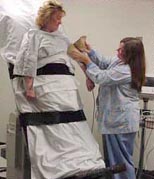Tilt Table
 Why is the doctor performing this test?
Why is the doctor performing this test?
To determine why you are fainting (fainting is also called syncope).
What is the test?
Fainting or syncope occurs by several different mechanisms. It is important to determine the cause of the syncope to understand the risks and severity of future fainting episodes. A tilt table can provide this information.
The most common type of syncope is vasovagal syncope due to an abnormal neurological reflex. While this cause of fainting can be frightening to those who witness it, it is rarely life-threatening. People with simple fainting experience a sudden drop in blood pressure, and/or heart rate often while they are standing or sitting.
During a tilt test the patient lies on a table and is connected to an ECG machine and a blood pressure cuff on one arm. The table is then tilted upwards (head up) to 60-70 degrees. The patient will have comfortable straps over their legs and lower chest for a sense of security. The table is kept up for 15-30 minutes with the patient’s heart rate constantly monitored and blood pressure checked every minute. If there is no response, the table is lowered to flat and a medication my be administered through an IV. The table is then taken back up for another 15-30 minutes. If the patient develops symptoms of light-headedness or fainting the table is laid flat and the test is terminated.
Where is the test performed?
The test is performed in the Non-Invasive Cardiology Testing Area.
How long does this test take?
Surgeries
- Abdominal Aortic Aneurysm Repair
- Bypass Surgery
- Carotid Endarterectomy (CEA)
- Coronary Artery Bypass Surgery (CABG)
- Transmyocardial Revascularization (TMR)
- Valve Repair Surgery
- Valve Replacement Surgery
Procedures
- Ablation
- Angiojet Thrombectomy
- Aortagram
- Atherectomy
- Automatic Implantable Cardioverter Defibrillators (AICD or ICD)
- Coil Embolization
- Computed Axial Tomography (CAT or CT)/Ultrafact Computed Tomography (CT) Scan
- Coronary Balloon Angioplasty & Stenting
- Coronary Catheterization
- Dobutamine Stress Echo
- Echocardiography (ECHO)
- Electrocardiogram (EKG/ECG)
- Electrophysiology Study (EPS)
- Event Recorder
- Holter Monitoring
- Inferior Vena Cava (IVC) Umbrella Placement
- Intraaortic Balloon Pump
- Intracardiac Ultrasound (ICE)
- Intravascular Ultrasound (ICE)
- Magnetic Resonance Imaging (MRI)/ Magnetic Resonance Angiography (MRA)
- Medicated Stents
- Nuclear Stress Tests
- Pacemakers
- Percutaneous Transluminal Angioplasty (PTA)
- Percutaneous Transluminal Coronary Angioplasty (PTCA)
- Peripheral Stents
- Peripheral Vascular Angiography
- Radiation Brachytherapy
- Septal Closures
- Signal Averaged Electrocardiogram (SAECG)
- Stents
- Stress Echocardiogram
- Stress Test
- Thrombolytic Treatment
- Tilt Table
- Transesophageal Echocardiogram (TEE)
- Valvuloplasty
